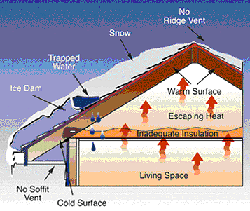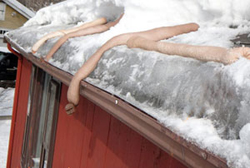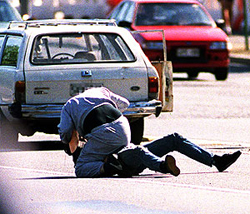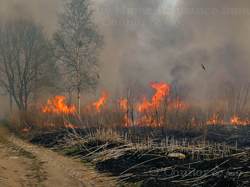How to remove ice dams from roof safely.
Winter presents homeowners with many unique challenges as the weather changes. Among the winter-fueled obstacles that come each year, ice dams can be one of the most serious. Ice dams that build along the edges of the roof can add to the amount of snow and precipitation that will accumulate. A snow-packed roof is bad news. Preventing the accumulation of ice on the roof edge should be a regular part of every homeowner’s annual winter preparation.
Ice dams form because of the roof’s uneven temperature. The roof becomes heated directly above the interior spaces of the house.  However, this heat does not reach the edges and the overhang. As a result, melted snow and rain will flow to these areas where it will freeze once again. Allowing your roof to maintain an even temperature starts with insulation. Your goal is to stop warm air in the house from flowing into the attic. To do this, seal all the gaps in addition to ensuring that all of the insulation is in good shape. The ideal temperature for the roof deck itself is 30 Fahrenheit. When the entire roof maintains a consistent temperature, the snow eventually clears evenly and naturally. It is also critical to have good ventilation between the roof deck and the insulation. Poor ventilation leads to the accumulation of moisture in this area. Excess moisture compounds your problems by encouraging lamination deterioration and mold growth.
However, this heat does not reach the edges and the overhang. As a result, melted snow and rain will flow to these areas where it will freeze once again. Allowing your roof to maintain an even temperature starts with insulation. Your goal is to stop warm air in the house from flowing into the attic. To do this, seal all the gaps in addition to ensuring that all of the insulation is in good shape. The ideal temperature for the roof deck itself is 30 Fahrenheit. When the entire roof maintains a consistent temperature, the snow eventually clears evenly and naturally. It is also critical to have good ventilation between the roof deck and the insulation. Poor ventilation leads to the accumulation of moisture in this area. Excess moisture compounds your problems by encouraging lamination deterioration and mold growth.
Soffit vents are also a valuable tool for fighting ice dams. These kinds of vents allow cold air to circulate beneath the entirety of the roof. Additional material that ensures seals may be needed during the winter as well. Adding extra insulation in extreme conditions never can hurt. Ice damming could also be related to the deterioration of the flashing around chimneys and other roof gaps. Sealing and insulating ducts and duct pipes that flow through the roof and attic also keeps heat from leaking towards the underside of your roof. Fiber-reinforced mastic on the joints of HVAC ducts can do wonders for heat retention.
In the event that you are experiencing ice dams during the winter, there are a few symptoms that indicate that you may have a problem. Ice dams on the roof will cause specific areas of the roof to transmit cold temperatures. Despite insulation, the area where the ice dam has formed will transmit its lower temperatures through to the trusses that connect with your ceiling. As this cold spot comes in contact with the home’s warm air, condensation occurs. The moisture traps dust and eventually forms mildew that will appear darker than the rest of the ceiling. When this occurs, begin by bleaching the mildewed surface. In some cases, this cleaning will be enough to remedy the problem. However, excessive staining can require a stain-blocking primer and a layer of paint. Should the trusses become cold enough to actually shift as they contract, you are likely to see cracks appear along the joint of the ceiling and the wall. These cracks can be caulked temporarily. The best long-term solution is to cover the joints with molding. Attach the molding only to the ceiling so that it is free to move with the structure as the temperatures fluctuate.
Tips to help with ice dams
Making a homemade Ice melt socks by using old panty hose can create melt channels in the ice dam. These channels will allow melted  water from your roof to drain off your roof, reducing the ice dam effect. This method may look & sound funny, but it is one of the safest way to create a melting path without heating cables or chipping away at ice dams. Make sure you use ice melter that is safe for your roof, check with your local hardware expert on this prior to using.
water from your roof to drain off your roof, reducing the ice dam effect. This method may look & sound funny, but it is one of the safest way to create a melting path without heating cables or chipping away at ice dams. Make sure you use ice melter that is safe for your roof, check with your local hardware expert on this prior to using.
Always take caution when attempting to remove any ice damn, consult with a professional first. Your safety comes first.
Winter can be enjoyed when you are properly prepared!
Now is the time to start your preparations for winter 2012-2013 and the storms that will undoubtedly be coming our way. As extreme weather events in New England continue, we can no longer get by with our old assumptions that all we need is a few flashlights to get by. The storms are getting bigger and more frequent and that means more damage throughout the area and more days potentially without heat or electricity. Now is the time to create your own “survival” plan and to gather what you may need.
the storms that will undoubtedly be coming our way. As extreme weather events in New England continue, we can no longer get by with our old assumptions that all we need is a few flashlights to get by. The storms are getting bigger and more frequent and that means more damage throughout the area and more days potentially without heat or electricity. Now is the time to create your own “survival” plan and to gather what you may need.
Sometimes, winter storm warnings are given well in advance so that we have time to prepare or change our schedules. One idea is to organize your commuting plans in advance so you are able to carpoolwith someone who has four-wheel drive. Storm advisories often can turn into warnings. Just because you may be in an advisory zone may not mean you are off the hook. You could find yourself in an outer band of rain/ice mix, which is just as dangerous as a snowstorm.
A Northeaster, more commonly referred to as a Noreaster, is exclusive to New England winters. These types of storms start in the Atlantic in the fall or winter months. Think of this storm as a snow-filled hurricane, with high winds and blizzard conditions dumping snow measured in feet, not inches.
Given the extremes, it makes sense to have a plan and emergency supplies before we face any weather alerts. The familiar sight of televised storm coverage with people in long lines buying supplies and stores selling out of the things we need the most does not have to happen to you. Take inventory now and start to pull together your winter home emergency kit, which should include:
- Extra batteries for flashlights, radios.
- Emergency charger for cell phone (some hand-crank powered weather radios offer this feature).
- First aid kit stocked with bandages, sanitary wipes, gauze and rubbing alcohol.
- Battery-powered lanterns for ample light in each room (in a pinch, you can raid your Christmas decorations for battery-powered LED lights).
- Warm blankets to add to bedding when you have no heat.
- Emergency supply of prescription medication that you may need.
- Over-the-counter medications that you may need, such as analgesics.
It is a good rule of thumb that each person will require a gallon of water per day in reserve if we lose access to our water supply. Think of food that does not need to be cooked. Canned beans and vegetables, boxed cereals and energy bars are good choices.
Make sure you have a handle on exterior issues too. Your shovel or snow blower needs to be in good working order and in an accessible location. If you have a generator, test it in the fall to make sure it is in good working order and that the you have sufficient fuel. Clean your gutters now and again after a snowstorm and remember to check for ice dam formations along your roofline. Clearing gutters helps ensure that melting snow can flow freely without collecting on the roof and causing a potential leak or worse, a collapse. Many area hardware stores sell roof rakes. If you are not able to clear your roof or gutters on your own, arrange ahead of time for someone to do this for you.
Preparations can help ease the stress of demanding winter conditions too. So anticipate what you might need, and pack plenty of patience along with those extra supplies because when it comes to winter in New England we can always expect some of the unexpected.
School will be out soon, and now would be a good time to reserve your student driver magnet.
Reduce the stress of learning to drive; tips for the teacher and student.
Getting behind the wheel of a car for the first time can be an  unnerving experience. Student drivers may face impatient drivers and honking horns when they stop at a yellow light instead of blasting through. Other drivers may stare at the student who hesitates before taking a turn at a busy intersection. Some may even tailgate as the inexperienced driver proceeds at a cautious speed, perhaps even below the speed limit.
unnerving experience. Student drivers may face impatient drivers and honking horns when they stop at a yellow light instead of blasting through. Other drivers may stare at the student who hesitates before taking a turn at a busy intersection. Some may even tailgate as the inexperienced driver proceeds at a cautious speed, perhaps even below the speed limit.
O’Connor and Co. Insurance thought that one way to help our student drivers, and those with whom they share the road, is to have a “Student Driver” magnet on the student driver’s car. We are offering our customers who have a student driver in the family a chance to borrow a “Student Driver” magnet for their car while the student learns to drive. Even our customers who are adult student drivers can take advantage of this offer.
Most drivers will appreciate the “heads up” of knowing that they share the road with a new and inexperienced driver. The bright yellow ”Student Driver” magnet alerts other drivers to the presence of a novice driver and they will likely be more forgiving, patient and cautious.
Instead of finding the magnets embarrassing, most student drivers appreciate them. They know that other drivers understand the stress of driving for the first time and they are more confident knowing that they won’t be harassed. “Student Driver” magnets allow the inexperienced driver to be more relaxed behind the wheel. As anxiety declines, the novice driver can better focus on following the rules of the road and good driver safety practices.
Customers of O’Connor & Co. Insurance Agency, Inc. can contact our office in Dudley, MA, at 508-943-3333 and reserve a “Student Driver” magnet for up to 90 days. When customers pick up a magnet, they will be asked to leave their name, phone number and email address. When finished with the magnet, simply return it so we can give it to someone else.
Click to reserve your student driver magnet today!
AT&T Don’t text while driving documentary.
To learn about the dangers of texting and driving please watch this video.
How to safely discard prescription drugs.
There are many reasons why leftover Medications end up remaining in our possession longer than they should. Any good home safety program should include the proper disposal of these potentially dangerous substances on a regular basis. Every household should plan a time and method to throw away expired and unnecessary prescriptions. O’Connor Insurance in Dudley MA wants to help keep you and your family safe.
Prevent children or other individuals from Accidentally ingesting these substances by following the suggestions of the Food and Drug Administration (FDA). When you purchased your medicine the Pharmacy provided you an information drug sheet that outlines methods for proper and safe disposal of the prescription.
The drug sheet includes information on appropriate disposal methods. Some medications, such as powerful narcotic pain relievers and other controlled substances can create harmful side effects including Accidental death. These substances, the FDA recommends flushing down the toilet or sink drain as the method that presents the least immediate risk to the safety of adults, children and pets. Do not flush other type of medication into a sewer or septic system. Trace amounts of drug residues have been found in groundwater, lakes and streams so this type of disposal should be reserved only for the most dangerous drugs. There are concerns that the regular flushing of medication could contaminate the environment and drinking water supply.
The Food and Drug Administration(FDA) and the Drug Enforcement Administration (DEA) have developed a medicine take-back program. This national, annual event provides medication drop boxes in many communities. If you do not want to wait for the next date, there are other ways to regularly dispose of unused prescriptions in your household trash.
Liquid, tablet and capsule forms of medication should be mixed with an unpalatable, absorbable substance such as coffee grounds or kitty litter. A zip closure plastic bag keeps the contents from leaking out. This mixture should be placed in a container that will be difficult for a child to access. Place this into your household trash. All emptied prescription vials or bottles should have the label removed or identifying information rendered unreadable. This is a short term solution, plan to participate in future medicine take-back programs so you do not have to dispose leftover prescriptions this way however.
Brush fire safety tips from O’Connor Insurance
100’s of Brush fires occurs every year across the Commonwealth. You do not have to live in dry, mountain regions of the West to be threatened by Brush Fires. A Brush Fire only needs the right conditions and fuel to become a wild fire. Dry weather, high winds, and trees or brush substantially increase the chances of an uncontrolled fire. Even areas like ours in Central Massachusetts can be at risk for Brush Fire, especially during dry, windy periods.
The time to protect your family from a brush fire is before a fire starts. O’Connor & Co. Insurance Agency from Dudley MA, offers some Brush Fire safety tips for residents of Massachusetts. These tips can help those with a house in or near wooded areas or brush to make their homes less susceptible to damage from a Brush Fire or wildfire.
Prevention Measures
Preventing a Brush Fire from reaching your home may not be foolproof, but it can dramatically reduce the chances that your home will be destroyed from a Brush Fire. These tips also help to keep home fires from becoming Brush or Wild Fires by creating a barrier between the woods and your home.
Remove large areas of brush, leaf piles, and woodpiles from a 30 to 100-foot radius around your home. Keep matches away from children and teach them about fire danger. Use only roofing and siding material on your home which is fire-resistant. Keep trees and bushes on your lot trimmed, and have dead trees removed immediately. Do not store flammable materials within 15 feet of chimneys, barbecue grills, or propane tanks.
Plan for a Brush Fire
A little bit of planning before you burn brush could help firefighters battle a Brush Fire near your home. It may never be needed, but you will be glad you took the time to put these measures into place if it is.
Make sure your driveway is free of impediments so that a firetruck can reach your property if necessary. Keep a shovel, rake, bucket, and an ax or saw on hand while you are burning.Have a ladder to reach the roof ready and accessible. Make sure your hose is long enough to reach the immediate area where you are burning. Only burn during the legal time period established by your local fire department and obtain all the necessary burning permits required in your town. Make sure you have smoke detectors in every bedroom and floor of your home, and test them prior to burning and monthly thereafter. Take photographs of all your valuables and keep a record of them in a fireproof safe to make filing a claim with your insurance company easier.
When a Brush Fire is in the Area
Sometimes, no matter how much planning you do, brush and wildfires may still appear in the area and threaten your home. If you are told to wait in place until an evacuation order is given, do it. If you try to evacuate too soon, you could get in the way of firetrucks on the road.
While waiting to be told to leave prepare your home. Wet the roof and landscape plants around your home to make them less likely to catch fire. Shut off the power and gas to your home and turn off any propane tanks outside. Push wood furniture inside your home to the center of each room, as far from exterior walls and windows as possible. Gather your family and pets together with a disaster kit into a single room to make finding everyone easier when the evacuation order is given. All your family members should know how to contact each other if you become separated.
Living near the tranquility of nature comes at the price of being in proximity to Brush and wild Fires, but if you prepare your home and family with these Massachusetts wild and brush fire tips, you can substantially reduce the potential for damage to your house or harm to your family members.
Super Bowl Party Safety Game Plan.
Super Bowl Party Safety Tips
Congratulations to the New England Patriots and now they get another trip to the Super Bowl. Here at O’Connor & Co. Insurance, we will cheering along with all the Pats fans in our area, but most of all we want you to enjoy the game and your safety means a lot to us. So we put a small list of tips to stay safe during your Super Bowl Party. Feel free to add anything else we might have left out.
Tip #1.) Be careful to keep that nice TV upright.
- People jumping up and down can actually cause the TV to get knocked over, so make sure your TV is safely mounted.
- Make sure your furniture is secure on its own. If you need to put proper hardware in to any furniture that should be bracketed to the wall, please do so.
Tip #2.) Don’t “hide” those extension cords.
- Hiding those cords under the carpets or heavy items can lead to wear and tear and could potentially cause a fire. Please don’t use cords that are cut or damaged.
- Do not plug too many items into one outlet, this could also cause a fire or outage.
Tip #3.) Cooking Safety
- Do your grilling outside.
- Be very careful if you use a turkey fryer see video
- Stay in Kitchen when cooking.
Please feel free to comment on anything we might have left out.
Wood and pellet stove safety tips.
Does anyone remember the winter of 2010? The record snowfalls, the treacherous commute to work, the repeated cancellations of school, the ice dams, the leaking roofs and on and on and on.
Well, Old Man Winter is suiting up again, and with a chilly weekend forecast, it reminds us that the Old Man never really gets old and tired. For some reason, he never forgets to stop by each year for a visit, sometimes longer than most would like to see him.
One of the best and least expensive ways to take the chill out of winter and save money heating your home is a wood and pellet stove. At O’Connor & Co. Insurance your safety is what keeps us warm. We’ve put a list together of safety tips and great links to keep you and your family protected from accident and traumatic loss.
- Check Your Hotspots: The USFA believes in educating people how to recognize some of the hazards to help prevent wood stove mistakes. Click here for more information.
- Teach your children the value of wood stove safety. Click on this link for a great for children
- Creosote buildup in the fireplace can lead to danger. Click on link for more information.
Stay calm while driving. Keep your auto insurance rates low.
Driving on the road can be a challenge nowadays, I have been driving  for over 30 years and do not remember such hostility that we face on our roads today. I try to drive the speed limit and can’t tell you how often I feel like I am in going in slow motion. I often ask myself, “Why are we going so fast?” I think I have some great reasoning for staying calm and safe on the roads. Here are just a couple of reasons.
for over 30 years and do not remember such hostility that we face on our roads today. I try to drive the speed limit and can’t tell you how often I feel like I am in going in slow motion. I often ask myself, “Why are we going so fast?” I think I have some great reasoning for staying calm and safe on the roads. Here are just a couple of reasons.
- My safety, the safety of my family, and the safety of other families .
- Speeding tickets last a long time and will go against my insurance policy and I like to keep my money for other things.
- Fuel Efficiency vs. Speed
How Much? According to studies backed by the Department of Energy, the average car’s MPG is advertised at 55 mph. But as the speed increases:
– 3% less efficient at 60 mph
– 8% less efficient at 65 mph
– 17% less efficient at 70 mph
– 23% less efficient at 75 mph
– 28% less efficient at 80 mph
That means that there are many more fill-ups needed at the gas station, costing you an unnecessary expense. So let me ask you. Is it worth it to be fast?
Leading causes of house fires and tips for your items in your home.
Fires can be a devastating event and all of us at O’Connor & Co. Insurance we hope you never have to experience such a traumatic event.
We at O’Connor have compiled a list of some of the leading causes to home fires. We hope this blog will help you take some extra precautions.
The latest reported figures, accidents attributed to cooking generated more residential fires more than any other known cause. The leading cause of residential fire deaths is careless smoking.
We also provide a link to a free home inventory checklist at the bottom of this page.
Some of causes of reported fires include:
- Cooking 20%
- Unknown 18%
- Heating 15%
- Suspicious Causes (arson) 11%
- Appliances 8%
- Smoking 5%
- Open Flame 5%
- Children Playing 4%
- Other 4%
- Exposure 3%
3 Tips for inventorying for your home.
- Take a video camera through your home and verbally describing all the items in your home.
- Take pictures with a time stamp on the image. On the back of the image, list the value, serial number, make and model number. If you’re storing it electronically, name the pictures and reference the description.
- If you have an iPhone® download a free app from the National Association of Insurance Commissioners, myHOME Scr.APP.book app. It guides you through capturing images, writing descriptions, saving bar codes and serial numbers, and stores them all electronically.



